
Food Safety Bulletin (2nd Issue of 2015)
Feature Article
"Reduce Salt, Sugar, Oil. We Do!" Programme ─ Experience Sharing by Founder of King Bakery
High salt (sodium) intakes can lead to hypertension and cardiovascular disease, hence an increased risk of fatal stroke and coronary heart disease. Excessive consumption of sugar, on the other hand, has been associated with a higher risk of overweight, obesity and dental caries. In fact, the World Health Organisation has been advocating a restriction on the intake of sodium and free sugars to reduce the morbidity and mortality rates of non-communicable diseases (NCDs) globally. In Hong Kong, such NCDs like hypertension, stroke, coronary heart disease and obesity have aroused health concern. As unhealthy eating habits are among the contributing factors to these NCDs, the Centre for Food Safety (CFS) attaches importance not only to the promotion of food safety but also healthy eating.
In August 2014, CFS launched a programme entitled "Reduce Salt, Sugar, Oil. We Do!" (the Programme) to actively engage the trade in creating an enabling environment to help patrons reduce salt, sugar and fat intake while dining out. Restaurants are encouraged to make reference to the "Trade Guidelines for Reducing Sodium in Foods" and the "Trade Guidelines for Reducing Sugars and Fats in Foods" in preparing foods, and to advise patrons to order dishes prepared with less salt, sugar or oil based on their needs and preferences. Since the introduction of the Programme, many signatories of the Food Safety Charter have shown support by providing healthier food choices for customers.

In this issue, we have invited Mr John CHONG Yam-ming, the founder of King Bakery Holdings Limited, to talk about his unremitting endeavour in reducing salt, sugar and fat in foods. Mr CHONG, who founded King Bakery and his fast food and café businesses in 1993, has more than 50 years of experience in baking pastries. He is well aware of the health benefits of lower levels of salt, sugar and fat in foods. Over the years, he has been working incessantly to improve his recipes to gradually reduce salt, sugar and fat in egg tarts, bread, cakes and other food items. For instance, less salt can be used in bread making. It is also possible to mix flour for the tart crust without salt and sugar, and to reduce sugar in the filling of egg tarts by degrees. His egg tarts now contain sugar about 55% less than the recipe of the 1970s'. To Mr CHONG, the secret of success lies in continuous improvement of recipes. The sugar content is reduced every one to two years so that customers can get used to less sweetness in the products. This is a practical example of promoting healthy eating habits with less salt and sugar.
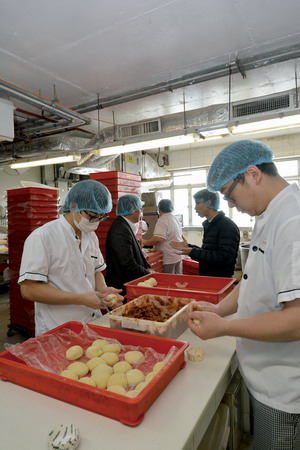

To reduce dietary intakes of salt, sugar and oil, CFS calls for the active participation of the food trade in the Programme to provide healthier food choices for the public. The names of the participating restaurants have been uploaded to the CFS website at www.cfs.gov.hk for public reference. The participating signatories are issued with the "Reduce Salt, Sugar, Oil. We Do!" labels, posters, stickers and other promotional items for display on the food premises. Their waiters/waitresses will wear the badge of the Programme and advise patrons to order dishes low in salt, sugar and oil. CFS, on its part, also organises nutrition and health seminars relating to the Programme for food trade practitioners and cooks at regular intervals. For more information about the Programme, please visit the "Food Safety Charter" webpage of CFS.
Readers' Corner
Nutrition and Health Claims on Formula Products and Foods for Infants and Young Children
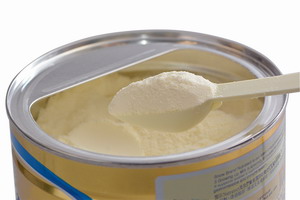 Nutrition is essential for the normal growth and development of infants and young children and the maintenance of their good health. However, the existing legislation regulating nutrition labelling and claims does not cover nutrition and health claims made on formula products and foods for infants and young children (IYC foods). In view of this, the Government earlier conducted a public consultation exercise to collect views on the proposed regulation of nutrition and health claims on formula products and prepackaged foods for infants and young children under the age of 36 months.
Nutrition is essential for the normal growth and development of infants and young children and the maintenance of their good health. However, the existing legislation regulating nutrition labelling and claims does not cover nutrition and health claims made on formula products and foods for infants and young children (IYC foods). In view of this, the Government earlier conducted a public consultation exercise to collect views on the proposed regulation of nutrition and health claims on formula products and prepackaged foods for infants and young children under the age of 36 months.
There are a wide variety of IYC foods with different ways of packaging advertised multifariously in the market. Can you clearly understand the nutrition claims and health claims of the various products?
What Are Nutrition Claims?
Nutrition claims are representations which state, suggest or imply that a food has particular nutritional properties. Such claims include nutrient content claims and nutrient comparative claims.
- Nutrient content claim describes the content level of a nutrient contained in a food. Some common examples are "with DHA" and "excellent source of vitamins".
- Nutrient comparative claim compares the nutrient levels and/or energy value of two or more foods, such as "more fibre" and "extra iron".
What Are Health Claims?
Health claims are representations which state, suggest, or imply that a relationship exists between a food or a constituent of that food and health. Such claims include nutrient function claims, other function claims and reduction of disease risk claims.
- Nutrient function claim describes the physiological role of a nutrient in growth, development and normal functions of the body. For instance, "DHA supports eye and brain development" and "Phospholipids (PhD) are essential for the function of brain cells".
- Other function claims concern specific beneficial effects of the consumption of foods or their constituents on normal functions or biological activities of the body. For instance, "Probiotics helps maintain a healthy digestive system" and "Galacto-oligosaccharides (GOS) helps promote softer stools and reduce constipation".
- Reduction of disease risk claim relates the consumption of a food or food constituent to the reduced risk of developing a disease or a health-related condition. For instance, "Contains ganglioside (GA), which helps reduce the risk of enterovirus infection".
The Government proposes to enhance the regulation of nutrition and health claims on formula products and IYC foods. It has come up with five overarching principles in governing the scope of the regulatory framework, namely nutrition claims should be prohibited in infant formula; reduction of disease risk claims should be prohibited in formula products; nutrition claims and nutrient function claims should be permitted in IYC foods; nutrients or constituents permitted to be subjects of claims should be of high importance to the health of infants and young children; and nutrition and health claims must be scientifically substantiated and have undergone a credible evaluation process.
Factually correct nutrition and health claims can provide parents with useful information to arrive at informed choices. On the contrary, false or misleading claims on formula products and IYC foods, and their improper applications, may unduly affect parents' breastfeeding decisions and food choices, thus posing an adverse impact on their children's health. To protect the health of infants and young children, it is necessary to regulate such claims made and used on formula products and IYC foods. The Government will take into account the views received during public consultation before finalising the details of the legislative proposals.
Dimethyl Yellow in Food
The Centre for Food Safety (CFS) earlier collected from the market a batch of pre-packed dried bean curd imported from Taiwan for testing. The test result showed that the samples contained dimethyl yellow, a colouring matter which is not permitted for food use under the Colouring Matter in Food Regulations (Cap. 132H). In Hong Kong, it is an offence to sell food added with non-permitted colouring matters. The maximum penalty is a fine of $50,000 and six months' imprisonment.
As dimethyl yellow was found in the imported dried bean curd, CFS has instructed importers and retailers to stop selling and initiated a recall of the products. The Taiwanese authorities were also informed of the incident for follow-up actions.
Dimethyl yellow is an industrial chemical used as a dye for colouring polishes and other wax products, gasoline and soaps. The International Agency for Research on Cancer has classified dimethyl yellow as a Group 2B agent, which is possibly carcinogenic to humans. Although there have been researches showing that dimethyl yellow might cause cancer in experimental animals, no sufficient evidence has been found to confirm the impact of dietary intake of this colouring matter on human health. However, for the sake of prudence, consumers are advised to avoid consuming food products containing dimethyl yellow.
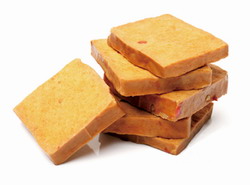 Food manufacturers should only use food colours permitted under Hong Kong laws and comply with good manufacturing practices. For consumers and child care providers concerned about food colours, they can check the ingredient list on the food label for names or identification numbers of food colours in order to make discerned choices.
Food manufacturers should only use food colours permitted under Hong Kong laws and comply with good manufacturing practices. For consumers and child care providers concerned about food colours, they can check the ingredient list on the food label for names or identification numbers of food colours in order to make discerned choices.
News on New Dishes
Duck Meat with Oatmeal Buns
When talking about Beijing cuisine, "Roasted Peking Duck" is always the first iconic dish springing to mind. We will often think of having the duck served "two ways" — thin slices of meat and crispy skin and a combination of duck meat and vegetables. In this issue, we have invited Chef WONG Wai-keung, Supervisor of Kitchen Department, "Empire City Roasted Duck", a signatory of the Food Safety Charter, to demonstrate how to prepare the delicious and not at all greasy dish "Duck Meat with Oatmeal Buns" through an innovative pairing of the traditional "Roasted Peking Duck" with a new accompaniment.
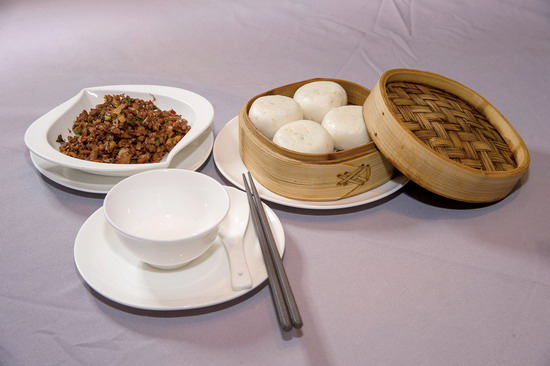
| Preparation Steps | Small Tips, Big Wisdom | ||
|---|---|---|---|
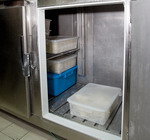 |
Receiving | Purchase ingredients such as ducks and grandmother vegetables (preserved vegetables in Hunan style) from approved and reliable sources. The duck is pre-roasted on the food premises. Minced pork is supplied by a licensed food factory of the restaurant group. | Upon receipt of the ingredients, check carefully to ensure their freshness. Minced pork should be stored at 4oC or below in a refrigerator for keeping raw meat. |
 |
Cutting | Slice the roasted duck and cut the meat into small cubes. Dice the ingredients including shallots, red chilli peppers and spring onions. Set aside. | If the cooking process is not expected to start within two hours, the cooked food (duck meat) should be stored at 4oC or below in a refrigerator for keeping cooked meat. If raw and cooked foods are stored in the same refrigerator, cooked foods should be kept in lidded containers and placed on the upper shelves to prevent cross-contamination. |
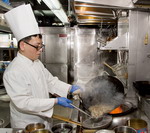 |
Blanching | Blanch the duck meat, minced pork and grandmother vegetables in boiling water for about a minute. Drain them dry and set aside. | Blanch the ingredients and cook the meat until half done can shorten the time for subsequent cooking at high temperatures. This can reduce the release of harmful substances such as polycyclic aromatic hydrocarbons during high heat cooking. |
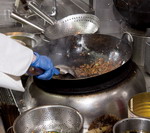 |
Stir-frying | Heat oil in wok. Stir-fry the shallots and red chilli peppers until fragrant. Then add the blanched duck meat, minced pork and grandmother vegetables. Lastly, put in spring onions, Shaoxing wine and an appropriate amount of seasoning to enhance flavour. Dish up. | Brisk stir-frying in wok can make ingredients smell and taste more delicious and ensure that they are thoroughly cooked. |
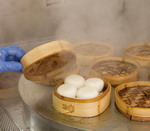 |
Steaming | Add oatmeal to knead a dough for making buns. Steam the buns in a stream cabinet. Scoop out the centre of the buns to form a bowl shape. | If the steamed oatmeal buns, the roasted duck and other ingredients that have been thoroughly cooked are not consumed immediately, they should be cooled down promptly and stored in the refrigerator within two hours. Food left at room temperature for more than four hours is no longer suitable for consumption. |
Tips from Chef WONG:
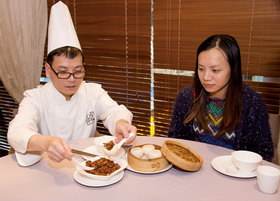
- Grandmother vegetables, a home-style specialty in provinces outside Guangdong, are a kind of mixed pickled vegetables made from Chinese white cabbage, string beans, etc. To reduce the salt (sodium) content of grandmother vegetables, soak the vegetables in boiled water before blanching. Discard the soaking water afterwards.
- After blanching, drain the ingredients thoroughly and stir-fry them briskly over medium heat until the moisture has evaporated. The ingredients will become dry and more delicious.
- When slicing the roasted duck, remove the fat as far as possible. This can reduce the intake of saturated fat and make the dish less greasy.
Food Safety Plan Corner
Duck Meat with Oatmeal Buns

Ingredients:
Steamed oatmeal buns, roasted duck meat, minced pork and grandmother vegetables
Other ingredients :
Shallots, red chilli peppers and spring onions
Steps:
- Slice the roasted duck. Cut the meat into cubes. Keep them chilled at 4oC or below for later use.
- Soak and rinse grandmother vegetables, red chilli peppers, spring onions and shallots. Dice and set aside.
- Add oatmeal to knead a dough for making buns. Scoop out the centre of the buns to form a bowl shape. Steam the buns in a steam cabinet. Steam until done.
- Blanch minced pork, diced duck meat and grandmother vegetables in boiling water for about a minute. Drain them dry and set aside.
- Heat oil in wok. Stir-fry shallots and red chilli peppers until fragrant. Then add the blanched minced pork, duck meat and grandmother vegetables. Lastly, add spring onions, Shaoxing wine and an appropriate amount of seasoning. Stir-fry until thoroughly cooked. Dish up.
- Put the steamed oatmeal buns on a plate. Ready to serve.
Production Process
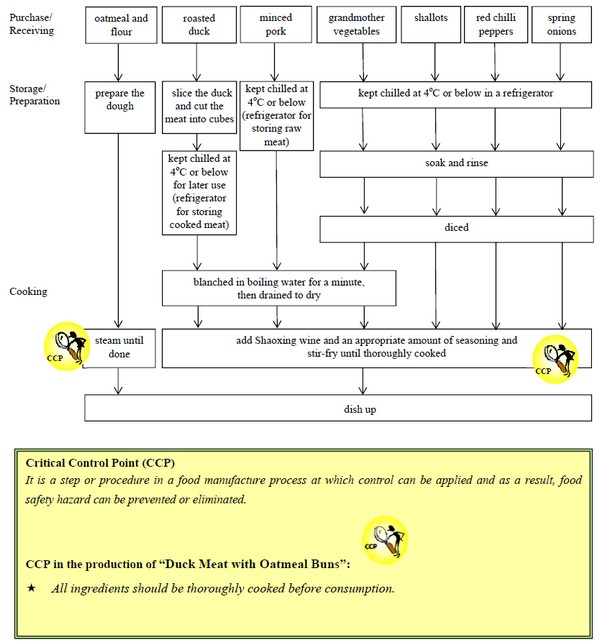
Briefing of Activities

Community Talks on Food Hygiene
The Centre for Food Safety (CFS) enhances food safety by spreading food hygiene messages to the public through a host of channels. For instance, health inspectors of its Communication Resource Unit (CRU) give talks on food hygiene and food safety in schools and community centres to share food-related knowledge with the participants, thereby heightening public awareness of food safety and promoting healthy eating habits.
CRU regularly issues letters to primary and secondary schools to introduce the various themes of their food hygiene talks, such as "Nutrition Labelling", "Food Poisoning", "Five Keys to Food Safety", "Natural Toxins in Food", "Veterinary Drug Residues in Food" and "Genetically Modified Food". Interested schools can reply and make an appointment. CRU will then arrange health inspectors to deliver a talk in the school and distribute leaflets and other publicity materials to the students.


Upcoming Activities
Food Hygiene Talks on "Hong Kong's Action on Salt and Sugar Reduction" (For the Public)
The theme of the Food Safety Day 2015 is "Hong Kong's Action on Salt and Sugar Reduction". To echo the theme, CFS will organise four related food hygiene talks from July to November 2015. The talks will provide some practical tips to facilitate better understanding of the health effects of salt and sugar, which will be conducive to promoting healthy diets by reducing salt and sugar intakes. Topics such as "Five Keys to Food Safety" will also be covered. It is hoped that with greater awareness of food safety and healthy eating, everyone can enjoy food in a safe and healthy way.
The talks, to be conducted in Cantonese, are open to the public free of charge. Participants will receive a certificate of attendance and a souvenir. For further details including the dates and venues of the talks, please browse the CFS website at www.cfs.gov.hk.
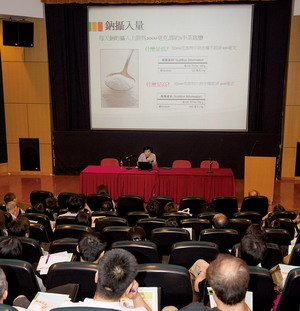

Food Safety Q&A
Is Your Dietary Sodium Intake Excessive?
Salt and sodium are often used synonymously. In terms of weight, salt comprises about 40% sodium. The World Health Organisation (WHO) recommends a daily sodium intake of less than 2 000 milligrams (mg) per person (slightly less than a level teaspoon of table salt).
Salt has multifunctional roles. It is added to foods for its taste. It can also inhibit microbial growth, extend product shelf life and improve the product texture. Sodium is naturally present in foods, and can be found in table salt, condiments and sauces used for cooking dishes. It may also be present in the diet as food additives in processed foods, e.g. sodium nitrate and monosodium glutamate (commonly known as MSG).
While sodium is essential for normal body functions, excessive sodium intake is associated with increased risks of hypertension, stroke and cardiovascular disease. WHO has pointed out that there is a dose response and a direct relationship between salt intake and blood pressure.
Local Dietary Sources of Sodium
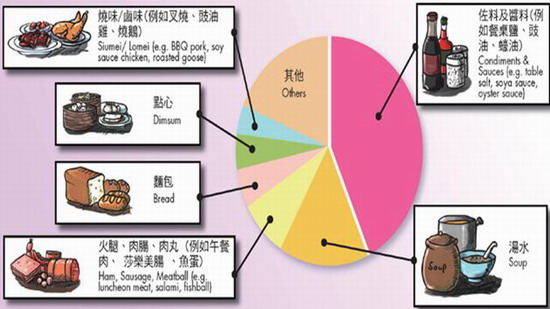
Sodium Content of Local Condiments and Sauces
Annex I: Sodium content of some local condiments and sauces
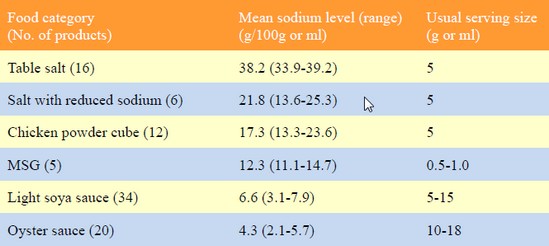
Remark: Information on the sodium content and the usual serving size of the various condiments and sauces is taken from the nutrition labels/food labels on some of these products put on sale in different supermarkets.
According to a study by the Centre for Food Safety, the major dietary source of sodium is condiments and sauces, such as table salt, soya sauce and oyster sauce.
Advice to the Public
- To reduce the amount of seasonings containing salt/sodium added to food at table.
- To order healthier dishes and request restaurants to use less salt in food preparation when dining out.
- To purchase less high sodium processed foods by making reference to nutrition labels.
Truth against Fallacy
Are Prepackaged Foods No Longer Edible After Shelf Life?
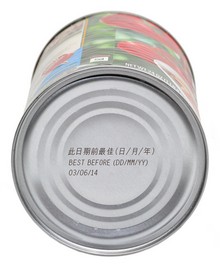 First of all, we need to understand the meaning of "best before" and "use by" dates shown on food packages. "Best before" dates are about food quality, such as taste, texture, aroma and appearance. They mean that if the food is stored properly, it can reasonably be expected to retain its specific properties, best taste and quality up to and including the specified date. "Best before" dates may be applied to foods, such as plain bread, that will show obvious signs of spoilage (e.g. mouldy, rancid or stale) before posing a food safety risk to consumers. On the contrary, "use by" dates are concerned with food safety. They are applicable to foods, which from a microbiological point of view, are highly perishable and are therefore likely after a short period to constitute an immediate danger to human health.
First of all, we need to understand the meaning of "best before" and "use by" dates shown on food packages. "Best before" dates are about food quality, such as taste, texture, aroma and appearance. They mean that if the food is stored properly, it can reasonably be expected to retain its specific properties, best taste and quality up to and including the specified date. "Best before" dates may be applied to foods, such as plain bread, that will show obvious signs of spoilage (e.g. mouldy, rancid or stale) before posing a food safety risk to consumers. On the contrary, "use by" dates are concerned with food safety. They are applicable to foods, which from a microbiological point of view, are highly perishable and are therefore likely after a short period to constitute an immediate danger to human health.
| After the "Best Before" Date | After the "Use By" Date |
|---|---|
| Foods kept in accordance with the manufacturer's instruction may still be safe for consumption, though not of optimal quality. However, consumers should avoid eating spoiled foods. | Inedible. The food may be unsafe for consumption even if it looks and smells fine, as the majority of food poisoning bacteria do not cause foods to spoil. |
Nevertheless, once the packaging for food is opened, the above suggestions as well as the date mark may become irrelevant. For instance, ultra-high-temperature treated milk can be kept safely in its sealed container without refrigeration for months; yet, after opening of packaging, bacteria can enter and begin to grow in the milk. We should therefore follow the manufacturer's instructions, for example "After opening, keep refrigerated at or below 4ºC and consume the product within seven days", regarding the length of time and way of storage after opening the food packaging.
Presently, there is no definitive list as to which foods should carry a particular type of date marks. The trade, particularly the manufacturers more familiar with the ingredients of their products and the ingredient properties, has the responsibility to use the appropriate date mark, i.e. either a "best before" date or a "use by" date and to give clear storage instructions (e.g. "keep refrigerated") which need to be observed if the food is to retain its specific properties until the expiry of the stated shelf life.
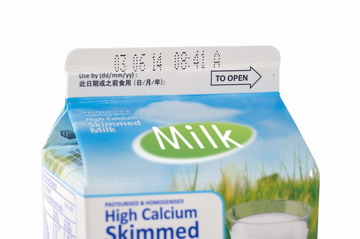
Brain Gym
Find Them Out
Please find three mistakes of the nutrition label from the diagram below:
Hint 1: Related to a nutrition claim.
Hint 2: Related to numerical values and their units of measurement.

Answers:
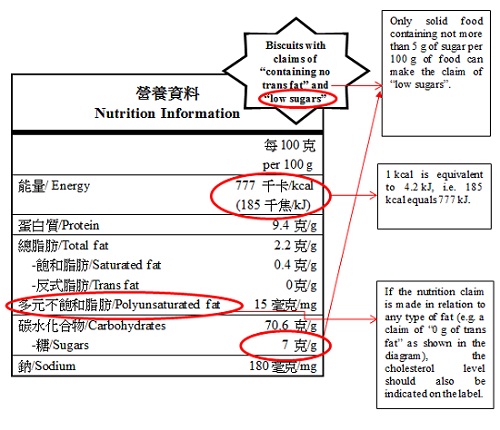
Enquiries and Subscription
Printed copies of Food Safety Bulletin can be obtained from the Communication Resource Unit at 8/F., Fa Yuen Street Municipal Services Building, 123A Fa Yuen Street, Mong Kok, Kowloon. For enquiries, please call 23816096. Members of the public may also visit the website of the Centre for Food Safety (www.cfs.gov.hk) for the online version.
| Enquiry hotline | 2868 0000 |
|---|---|
| E-mail address | enquiries@fehd.gov.hk |
| CFS website | www.cfs.gov.hk |